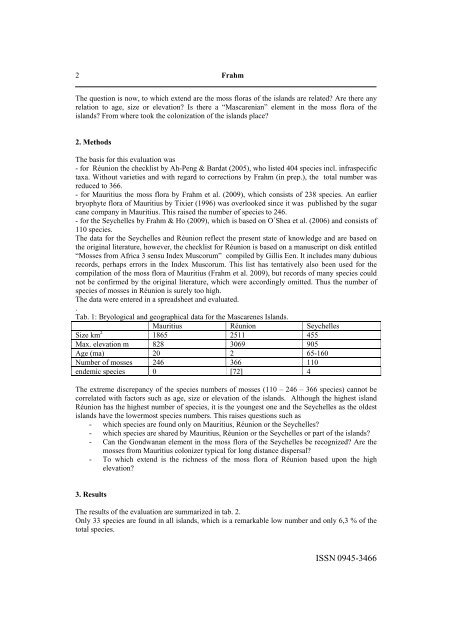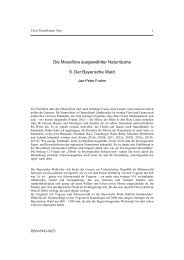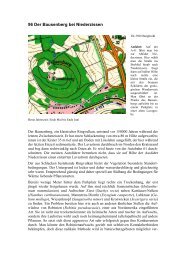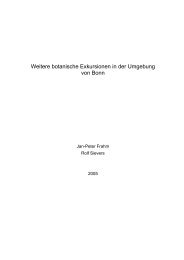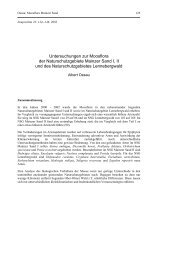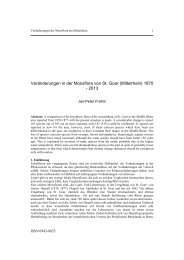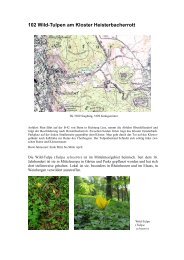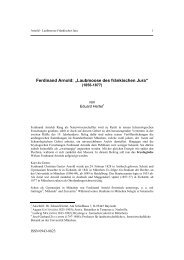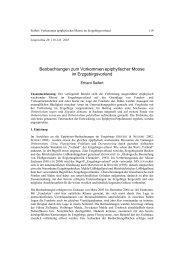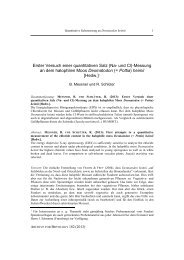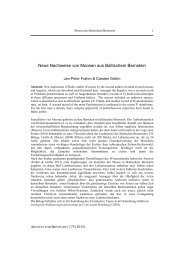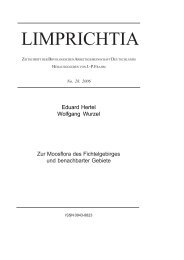Limprichtia xx: nn-nn, 2001 - Jan-Peter Frahm
Limprichtia xx: nn-nn, 2001 - Jan-Peter Frahm
Limprichtia xx: nn-nn, 2001 - Jan-Peter Frahm
Create successful ePaper yourself
Turn your PDF publications into a flip-book with our unique Google optimized e-Paper software.
2<br />
<strong>Frahm</strong><br />
The question is now, to which extend are the moss floras of the islands are related? Are there any<br />
relation to age, size or elevation? Is there a “Mascarenian” element in the moss flora of the<br />
islands? From where took the colonization of the islands place?<br />
2. Methods<br />
The basis for this evaluation was<br />
- for Réunion the checklist by Ah-Peng & Bardat (2005), who listed 404 species incl. infraspecific<br />
taxa. Without varieties and with regard to corrections by <strong>Frahm</strong> (in prep.), the total number was<br />
reduced to 366.<br />
- for Mauritius the moss flora by <strong>Frahm</strong> et al. (2009), which consists of 238 species. An earlier<br />
bryophyte flora of Mauritius by Tixier (1996) was overlooked since it was published by the sugar<br />
cane company in Mauritius. This raised the number of species to 246.<br />
- for the Seychelles by <strong>Frahm</strong> & Ho (2009), which is based on O´Shea et al. (2006) and consists of<br />
110 species.<br />
The data for the Seychelles and Réunion reflect the present state of knowledge and are based on<br />
the original literature, however, the checklist for Réunion is based on a manuscript on disk entitled<br />
“Mosses from Africa 3 sensu Index Muscorum” compiled by Gillis Een. It includes many dubious<br />
records, perhaps errors in the Index Muscorum. This list has tentatively also been used for the<br />
compilation of the moss flora of Mauritius (<strong>Frahm</strong> et al. 2009), but records of many species could<br />
not be confirmed by the original literature, which were accordingly omitted. Thus the number of<br />
species of mosses in Réunion is surely too high.<br />
The data were entered in a spreadsheet and evaluated.<br />
.<br />
Tab. 1: Bryological and geographical data for the Mascarenes Islands.<br />
Mauritius Réunion Seychelles<br />
Size km 2 1865 2511 455<br />
Max. elevation m 828 3069 905<br />
Age (ma) 20 2 65-160<br />
Number of mosses 246 366 110<br />
endemic species 0 [72] 4<br />
The extreme discrepancy of the species numbers of mosses (110 – 246 – 366 species) ca<strong>nn</strong>ot be<br />
correlated with factors such as age, size or elevation of the islands. Although the highest island<br />
Réunion has the highest number of species, it is the youngest one and the Seychelles as the oldest<br />
islands have the lowermost species numbers. This raises questions such as<br />
- which species are found only on Mauritius, Réunion or the Seychelles?<br />
- which species are shared by Mauritius, Réunion or the Seychelles or part of the islands?<br />
- Can the Gondwanan element in the moss flora of the Seychelles be recognized? Are the<br />
mosses from Mauritius colonizer typical for long distance dispersal?<br />
- To which extend is the richness of the moss flora of Réunion based upon the high<br />
elevation?<br />
3. Results<br />
The results of the evaluation are summarized in tab. 2.<br />
Only 33 species are found in all islands, which is a remarkable low number and only 6,3 % of the<br />
total species.<br />
ISSN 0945-3466


